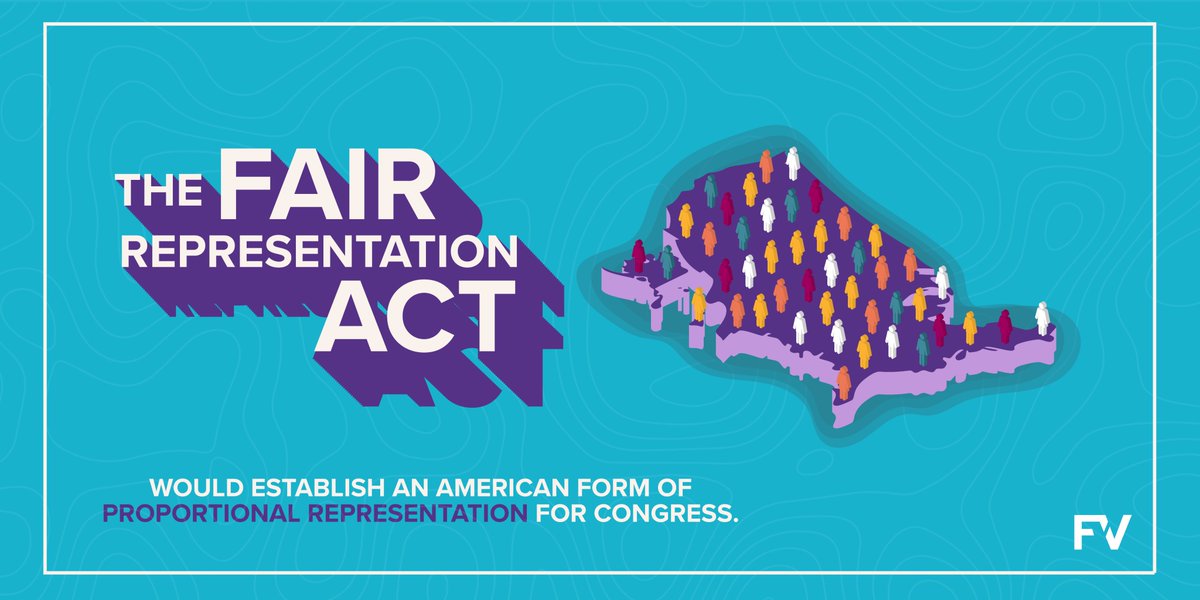
Today let’s talk about the #FairRepAct, which was just reintroduced in Congress by @RepDonBeyer
Whether you’re completely new to this reform, or a long time fan, there are lots of benefits to discuss so let’s get started.
bit.ly/2YDIC7n
Whether you’re completely new to this reform, or a long time fan, there are lots of benefits to discuss so let’s get started.
bit.ly/2YDIC7n

Here are the basics. Our democracy is struggling. Our elections feel fragile. We are more polarized than ever. Faith in democracy as an institution is failing. bit.ly/3p9hc5I
And that’s because of #winnertakeall elections
When only one person is elected to represent each district with #winnertakeall elections, it locks most voters into congressional districts that are increasingly skewed toward one party, and leaves too many voters unrepresented and powerless to affect outcomes.
We should want a Congress that looks like us. But many of us, whether you’re a Democrat in Louisiana or a Republican in Massachusetts, never have any real representation. This also means more polarization - elected officials worry more about primaries than the general election.
Millions of Americans -- whether urban Republicans, red-state Democrats, independents, women and communities of color -- are dramatically underrepresented, with little chance of fixing this at the polls.
This is where the #FairRepAct comes in.
The #FairRepAct consists of three core components:
1️⃣ #RankedChoiceVoting
2️⃣ Multi-member districts (MMDs)
3️⃣ Independent Redistricting Commissions (goodbye #gerrymandering 👋)
1️⃣ #RankedChoiceVoting
2️⃣ Multi-member districts (MMDs)
3️⃣ Independent Redistricting Commissions (goodbye #gerrymandering 👋)
1️⃣ #RankedChoiceVoting: A way to ensure elections are fair for all voters. It allows voters the option to rank candidates in order of preference.
If your vote cannot help your top choice win, your vote counts for your next choice.
bit.ly/introFRA
If your vote cannot help your top choice win, your vote counts for your next choice.
bit.ly/introFRA
2️⃣ Multi-member districts (MMDs): Rather than a single winner who represents an entire district, multiple people represent a portion of the district’s population.
The idea is to have the representatives be a miniature portrait of the population being represented.
The idea is to have the representatives be a miniature portrait of the population being represented.

EXAMPLE: You live in an area that is predominantly political party A, but you’re part of political party B. You can call your member of Congress on any issue you like, you can vote in every election, but there’s no one in Congress who represents your point of view.
But with MMDs, you will be part of a larger district with multiple representatives: Perhaps 2 aligned with Party A, and 1 aligned with your party, Party B. You will have a Member of Congress who will be more likely to advocate on your behalf.
3️⃣ Independent Redistricting Commissions — aka farewell #gerrymandering 👋
Gerrymandering is so out of control that there's a font that has been made out of gerrymandered districts. District lines are drawn based on political calculations, not representation. wapo.st/2Om90T4
The #FairRepAct makes #gerrymandering a thing of the past by using independent commissions to draw districts rather than politicians, and by ensuring no votes in a district are wasted.
Now you have districts made up of a more diverse group of voters, and representatives — elected via #RankedChoiceVoting — who reflect the views of those diverse voters.
Those are the three biggest pieces of the FRA, but you want even more reason to support it? It includes ranked choice voting for the Senate, too. #RCV in both the House and the Senate!
Badabing, badaboom, now you understand the #FairRepAct
BUT if you want to dive even deeper into the nuances of this reform, we’ve got a great page on the subject: bit.ly/2YDIC7n
BUT if you want to dive even deeper into the nuances of this reform, we’ve got a great page on the subject: bit.ly/2YDIC7n
• • •
Missing some Tweet in this thread? You can try to
force a refresh



